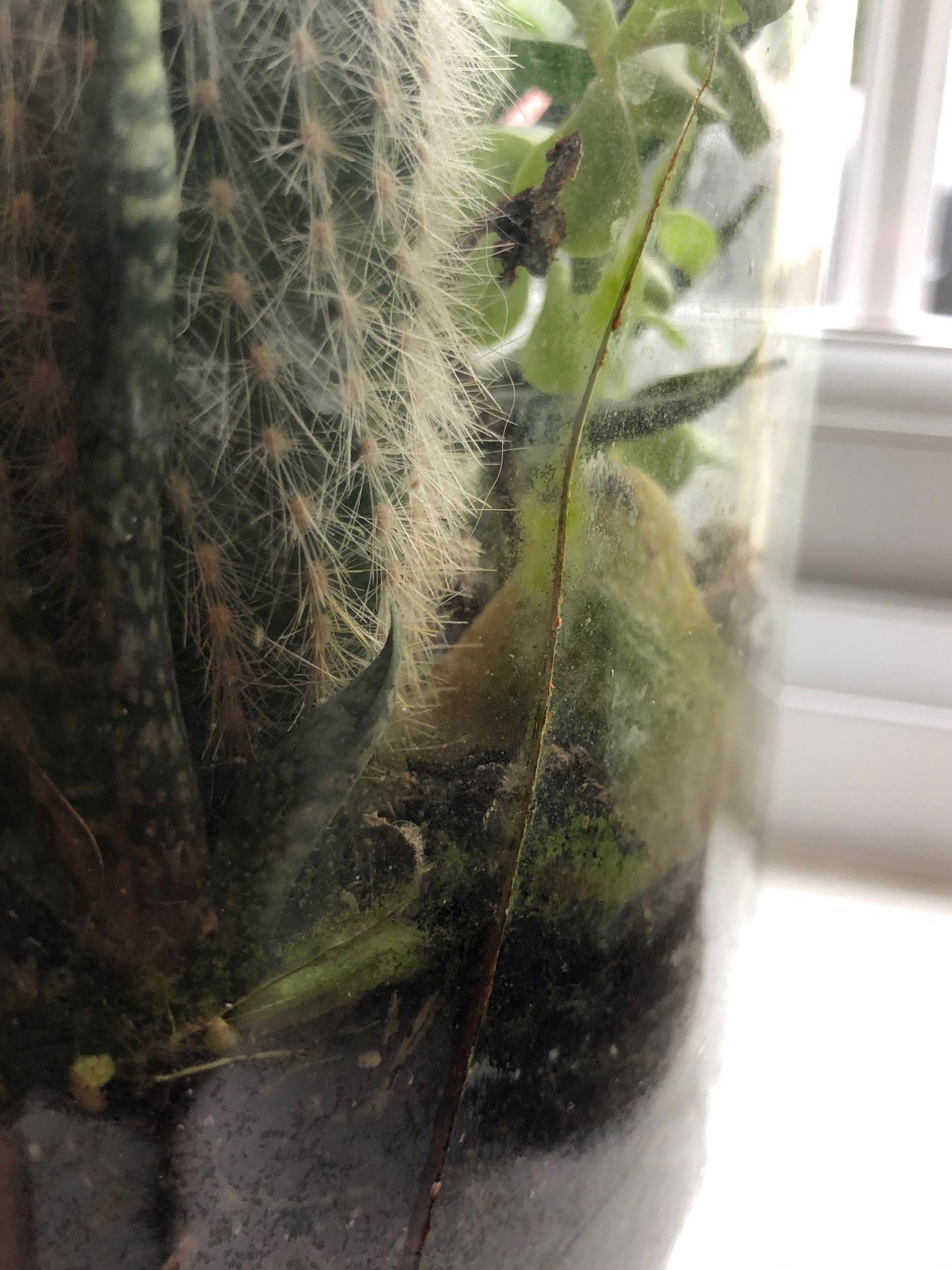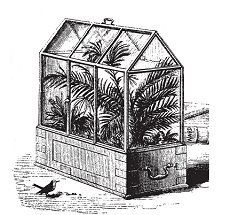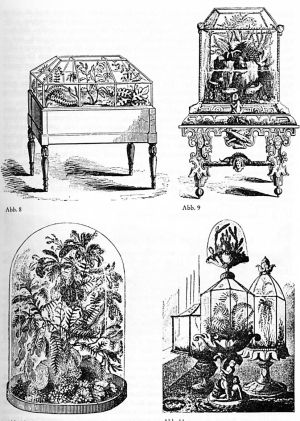Contents
1. Top Tips
2. Water, Location & Fertilisation
3. Common Issues
4. The History of the Terrarium
5. Temperature
6. The Out-Growing of Plants
7. Pests & Diseases
Need the answer to a specific terrarium query? Book a 1-to-1 video call with THE HOUSEPLANT DOCTOR™, the website's friendly author, to overcome and address your niggling problem! Available on iMessage, WhatsApp, Facebook Messenger & more.
Top Tips & Info
- A bright, indirect location is best, but avoid prolonged exposure to the sun, especially in the summer. An hour or two of winter sunlight is highly beneficial for new growth, as long as the plants are sufficiently hydrated (except for desert terraria (plural for terrarium)).Avoid shady locations where a newspaper cannot be read without artificial lighting due to the risk of root rot. Remove any rotten debris or plants to prevent a spread of disease (grey mould).
- Always be mindful of its lack of drainage and only water when wholly necessary.
- Keep an eye out for standing water accumulating in the basal stoned layer and into the soil.
- Terraria will generally last a few years before work will need to be done below the soil line. The plants and its soil may need to be replaced in favour of a fresh batch, as the compost can become anaerobic (lacking in oxygen) with over-grown plants.
- If you're interested in some of our displays that we've made over the years, be sure to click on this link!
Location & Light - 🔸🔸
Desert - Provide a location with an hour of sun during the spring and summer, while doubling this for the rest of the year to prevent over-watering (common in winter). Never situate a Desert terrarium in a darker location due to the issues raised above.
Tropical / Foliage - An hour or two of autumn and winter sunlight is acceptable as long as there's sufficient hydration. It's always better to provide a slightly brighter location than somewhere too dark, due to the risk chance of disease in shadier environments.
Carnivorous - Insect-loving plants love a splash of direct sunlight, so with this in mind, situate it in a location that offers at least two hours of sun throughout the year. Once the nighttime temperatures are above 12℃ (54℉), keep it outside so that the traps can naturally catch their prey. Just keep an eye out for aphids, droughts and sudden downpours.
Bonsai - A bright, indirect location is best for Bonsai. Because of their reduced ability to withstand prolonged droughts, it's essential to avoid direct sunlight due to the quickening of dry soil and potential sun scorch.
Moss - A bright location with a few hours of morning or evening sunlight is best, as most species will rely on natural lighting for nutrients. A common issue among growers is a rotten centre when situated in too much moisture and not enough light. Always avoid excessive sunlight, especially in the summer months when the rays are at their sharpest.
Enclosed Displays - Provide an hour of morning or evening sunlight, especially in the autumn and winter months. The relationship between natural lighting and the water-cycle within the display is paramount. Higher rates of photosynthesis will increase the water-uptake in the plant, that'll eventually be released through the leaves and back into the environment. A setting that has a reduced amount of natural light will entice grey mould to develop, along with root rot because of the water cycle's imbalance.
Water - 🔸🔸
Desert (Cacti & Succulent) - Keep the soil on the dry side by allowing it to dry out in between waters thoroughly. Periods of droughts will significantly reduce the risk of root rot (caused by over-watering) and will restrict the plants' growth. Avoid wetting the bodies of rosette-shaped Succulents (like Aloes & Sempervivums) to prevent decay. Irrigate using a tablespoon or pipette around the base of the cactus or succulent for controlled hydration.
Tropical / Foliage - Allow the top third of the soil to dry out in between irrigations, keeping in mind potential water-logging in the base. The most common issue with tropical displays is over-watering in a shady location. The darker the area, the less watering required!
Carnivorous - Periods of droughts should be avoided at all costs as the continuation of moist soil is critical for success. Carnivorous displays should be situated in direct sunlight, so the speed of its drying process will be doubled. The biggest problem with this type of display is, of course, under-watering, so always be sure not to fall into this trap!
As Bonsai like to be sat in good soil moisture, only allow the few inches to dry out in between waters. Both under and over-watering are common issues with Bonsai. Introduce a thin layer of grit on top of the soil to lock in the moisture for longer.
Moss terraria will rarely need to be watered when situated in an enclosed container, or every ten days in an open variety. Mist the foliage once every 7 - 10 days in the spring and summer months to prevent dehydration, reducing this further in the autumn and winter to replicate its dormancy period.
Enclosed displays will require infrequent watering due to its water cycle. As the plants take in the moisture from the roots for photosynthesis, they'll release water molecules back into the atmosphere via transpiration. Droplets will develop along the glass and accumulate in the base of the terrarium for the re-absorption of its roots. Open the lid every few days to improve the growing conditions and allow fresh air to circulate in the display.
Humidity - 🔸🔸🔸
Because of the proximity of plants, humidity shouldn't be an issue. This is due to transpiration where small amounts of water molecules are lost through their leaves, thus increasing the local atmospheric saturation.
A little word of warning is to avoid situating any terrarium (except for Desert displays) within three metres of an operating heat source, because of the dry air associated with radiators.
Fertilisation - 🔸🔸
Desert - Supplement every eight weeks throughout the year with either a Houseplant or Cactus & Succulent Feed.
Tropical / Foliage - Supplement monthly using a Houseplant Feed (sometimes referred to 'Foliage Plant') and every eight weeks during autumn and winter.
Carnivorous - Once the nighttime temperatures are above 12℃ (54℉), situate it outdoors to naturally catch its food (insects) in a sheltered location away from too much sun.
Bonsai - Choose between using a Houseplant, 'Foliage' or Bonsai labelled fertiliser. Always read the label as over-supplementation will result in leggy growth.
Moss - Sunlight is all that is needed for supplementation. As mentioned above, provide a few hours of morning or evening sun to administer the nutrients. When using tap water, allow it to stand for 24hrs in a non-metal container to remove the high levels of chloride or fluoride from the liquid.
Enclosed Displays - Never over-supplement the soil as it'll lead to a nutrient imbalance and the burning of roots. Use a soluble Houseplant or 'Foliage' feed and incorporate it into some water when it's time for irrigation. Reduce the recommended dilution strength by three quarters to avoid hurting the plants inside.
Common Issues with Terraria
Over-watering is by far the most common problem with terraria. Due to the absence of drainage holes, there's nowhere for the excess moisture to escape. Without being wary of the stoned-base layer becoming waterlogged, the oxygen will rise to the surface and exit the soil. Roots need an abundance of air to respire aerobically, and if all of the oxygen is stripped, root rot will quickly take over. If you've fallen into the trap with water rising into the compost, consider removing the plants and soil for a total revamp. If they still look healthy with no signs of root rot or distress, recreate the terrarium with a fresh batch of soil to improve the conditions. Click here to find out more about Terrarium making.
Wash the glass & leaves regularly. Although this isn't too much of an issue, a build-up of dust particles can clog up the plant's pores, causing lowered light capturing-efficiency. Wipe or rinse the foliage when it's time for irrigation to avoid over-watering. If you're a messy waterer, dried droplet-marks will develop along the inside of the glass. Despite this not being an issue with the plants' health, the overall visuals of the display will be tampered. Wash the glass using a damp cloth and remember NOT to use chemicals (like polish, soap, etc.) as this may hurt the plants long term.
If some of the plants begin to die, inspect their growing conditions. Remember to provide a bright, indirect setting with the correct amount of water. Plants tend to die because of over-watering and root rot, so have a check to see if the soil is overly-saturated. If you've over-fingered or damaged the root system during the move, the plant will go into transplant shock and could even die. For those that have bitten the dust, discard them and any rotten debris to prevent a spread of disease. Replace the specimens with an alternative from the same terrarium type and recreate the scenery or decorative layer. It's essential to evaluate its location, too - if a newspaper can't be read without the use of artificial light, relocate it. Always provide a terrarium-friendly environment that consists of a warm, bright location with the correct level of water.
Algae or moss developing along the glass is nothing to be worried about. Its causes could be due to an array of issues, including a lack of perlite used in the potting mix, waterlogged conditions and an absence of adequate light.
 Algae
Algae
Although it'll be challenging to remove wholly, there are a few ways out. Improve the growing conditions by easing off with the waters slightly and increasing the amount of natural light. Incorporate a SMALL amount of hydrogen peroxide into the water to increase the oxygen count, but always be aware of root burn. Finally, the next time you create a display that lacks in drainage, incorporate a better layer of grit or gravel at its base. If you're feeling a little extra, add a layer of activated charcoal to condition and regulate the bacteria (highly recommended). Algae is very beneficial for your display as it'll remove certain toxins from the soil. If you find it growing in your terrarium, it's a good sign of health!
Sometimes pests can become an issue. The most common inhabitants can are mealybugs in desert terraria, aphids for Bonsai & Carnivorous and spider mite with Tropical / Foliage displays. Scroll down to 'Pests & Diseases' for more info!
Mould developing on the soil means two things - too little light and over-watering. Despite the harmlessness of the mould, it'll prove unsightly to most gardeners and is therefore removed once known. To remove, replace the top two inches of the soil for a fresh batch of the appropriate compost. Either increase the amount of light received (no direct sunlight for the first few weeks to prevent environmental shock) or decrease the frequency of waters slightly. If the mould is accompanied by yellowing lower leaves, you may also have a case of root rot.
Origins
The history of the terrarium is fascinating and can be dated back to the 1830s. The creation of an enclosed environment was accidental when Englishman Dr Nathaniel Ward was collecting deceased moths and their cocoons in glass jars. Without his knowledge, a fern spore germinated and began to grow in one of the containers, arousing his interest of closed-environments for plants. This inspired Ward to create the first purpose-built sealed container - the Wardian Case. For those wondering, this is the direct predecessor of the 'Terrarium' that we know and love today!
 A Wardian Case made out of wood and glass. Note how it has handles for the mobility of tropical plants on explorer-ships back in the 19th century. Copyright: Wikipedia.
A Wardian Case made out of wood and glass. Note how it has handles for the mobility of tropical plants on explorer-ships back in the 19th century. Copyright: Wikipedia.
The European desire for undiscovered plants from The New World slowly intensified between the 16th and 19th centuries. Rare specimens would have to be transported back to Europe via a months-long (or even longer) boat journey, in the form of seeds, tubers or dried rhizomes. The combination of bad lighting and little fresh water, coupled with inadequate nutrients and salty air would test, and mostly defeat, the specimens' strength and agility. The use of a Wardian Case was soon implemented into long-haul boat journeys and immediately saw improvements. The enclosed environment of constant humidity, fresh water and its original soil meant that specimens would travel for months without any symptoms of stress. Over time, this accelerated tropical plant-imports significantly, with the overall cost of specimens beginning to decrease because of the higher quantity of stock.
Ward's invention would see many evolutions over the next following few decades, with containers being made out of metal instead of wood, and some with open lids. Owning a domestic Case with rare plants such as Orchids (which would fetch up to £ 36'000 at auctions) and Ferns would illustrate the owners' wealth and knowledge of horticulture. The oldest surviving Wardian Case was discovered in the Tregothan Estate (south U.K.) in 1999, which can be dated back to the 1880s!
 Domestic Wardian Cases were a pivotal moment in Houseplant History, due to the ability to grow tropical species in the toxic Victorian air!
Domestic Wardian Cases were a pivotal moment in Houseplant History, due to the ability to grow tropical species in the toxic Victorian air!
Temperature
15° - 26°C (59° - 80°F)
H1a (Hardiness Zone 13) - must be grown indoors or under glass all year round. Never allow temperatures to dip below 15℃ or permanent damage may occur in the likes of flower loss, stunted growth & yellowed leaves.
Pruning
Some plants may need to be pruned to remain in context with the display. Specimens like Bonsais can have a reduction in height to promote a bushier appearance; click here to find out more about directing growth towards via trimming! Be aware that many species, such as Parlour Palms, will not tolerate being harshly pruned and may even die as a result. Read up on ukhouseplants' Plant Articles for more information!
Pests & Diseases
 A Mealybug infestation on a Mamillaria
A Mealybug infestation on a Mamillaria
Terraria are susceptible to all pests and diseases, due to the proximity of the plants. The most common inhabitants can are mealybugs in desert terraria, aphids for Bonsai & Carnivorous and spider mite with Tropical / Foliage displays. Remove as much of the infestation (including the eggs, HQ and bugs themselves) using your hands or a small utensil. Get between the cubbyholes of the stem, the under-leafs and always remove any flowers that may house the infestation. Choose between using an organic or chemical-based pesticide, as both have positives and drawbacks. Click here to identify and address all the pests described above!
Diseases are a rare sight when terraria are cultivated correctly. Powdery mildew may arise when there's an excess of moisture on the foliage accompanied by poor air circulation. Botrytis, or grey mould, is the most common issue and occurs when rotten debris is allowed to fester on the soil line. Coupled with the moist air and darkened environment, this disease can develop and spread like wildfire. Root rot is the third most common disease, with symptoms including yellowing lower leaves, stunted growth and wilting. Have a look at the conditions below the soil line - if the soil is overly saturated or waterlogged, there'll be an absence of oxygen that'll result in root rot. For more information on how to address any of these issues, click on this link!
The Out-Growing of Plants
After a few years, the foliage inside may begin to outgrow their environment - this is the perfect time to redesign the display with a fresh batch of plants and soil. If, however, you're not bothered about nature taking its course to grow towards the light, keep it under control by removing any rotten debris and dying plants. The oldest surviving terrarium was created in the 1960s and is still reportedly thriving to this day with the original plants, so this step is entirely up to you!
Book a 1-to-1 Consultation with THE HOUSEPLANT DOCTOR™
Need realtime advice for creating or maintaining your terrarium? Book a video or message consultation with expert Joe Bagley, THE HOUSEPLANT DOCTOR™ (author or ukhouseplants.com). Choose between a ten or thirty-minute session & a platform of your choice (WhatsApp, FaceTime, Facebook Messenger or Zoom). Ask unlimited questions in one session, including queries on your dying/challenging plants, pests eradication, terrariums, repotting advice & everything in between! Available worldwide.